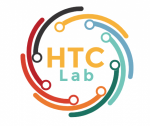Thanks to their generative capabilities, large language models (LLMs) have become an invaluable tool for creative processes. These models have the capacity to produce hundreds and thousands of visual and textual outputs, offering abundant inspiration for creative endeavors. But are we harnessing their full potential? We argue that current interaction paradigms fall short, guiding users towards rapid convergence on a limited set of ideas, rather than empowering them to explore the vast latent design space in generative models. To address this limitation, we propose a framework that facilitates the structured generation of design space in which users can seamlessly explore, evaluate, and synthesize a multitude of responses. We demonstrate the feasibility and usefulness of this framework through the design and development of an interactive system, Luminate, and a user study with 8 professional writers. Our work advances how we interact with LLMs for creative tasks, introducing a way to harness the creative potential of LLMs.
- Needed in Empirical Social Science: Numbers - June 23, 2024
- Investigating the Role of Explainability and AI Literacy in User Compliance - June 20, 2024
- Philosophical debate on use of AI in science - June 9, 2024
